NASA confirmed that nuclear-micropowered probes (NMPs) using tritium betavoltaic power technology is possible. A new study will raise from a valid concept to a proof of concept experiment. Nuclear-micropowered probes could be used for autonomous exploration of the Moon’s permanently shadowed regions (PSRs) and other space missions.
Tritium betavoltaics are a class of nuclear batteries that convert the beta decay energy of tritium (a radioactive hydrogen isotope with a 12.3-year half-life) directly into electricity via semiconductor junctions. They are like photovoltaic cells but powered by radiation rather than light. These devices are particularly appealing for long-duration, low-power applications in harsh environments, such as NASA space missions, where traditional batteries fail due to temperature extremes, radiation, or lack of sunlight
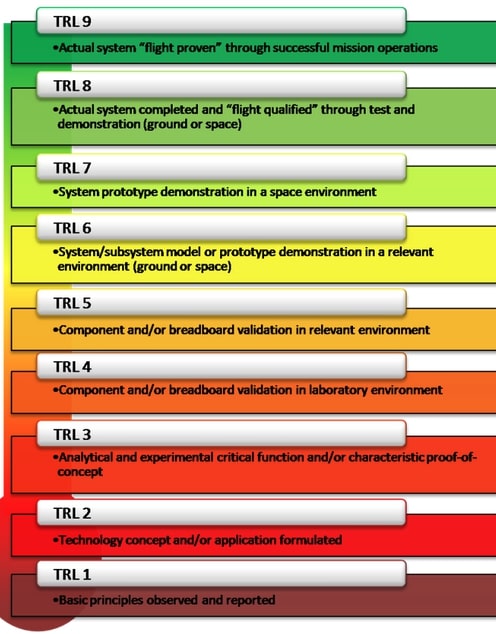
They will create a roadmap for further maturation toward TRL 4 and beyond, supporting NASA’s mission for lunar and planetary exploration.
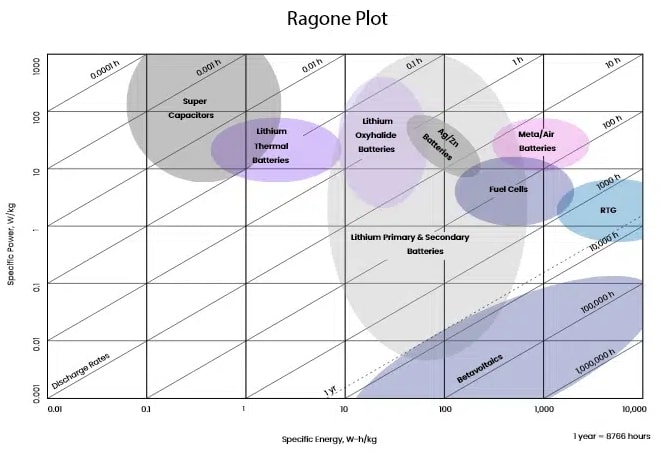
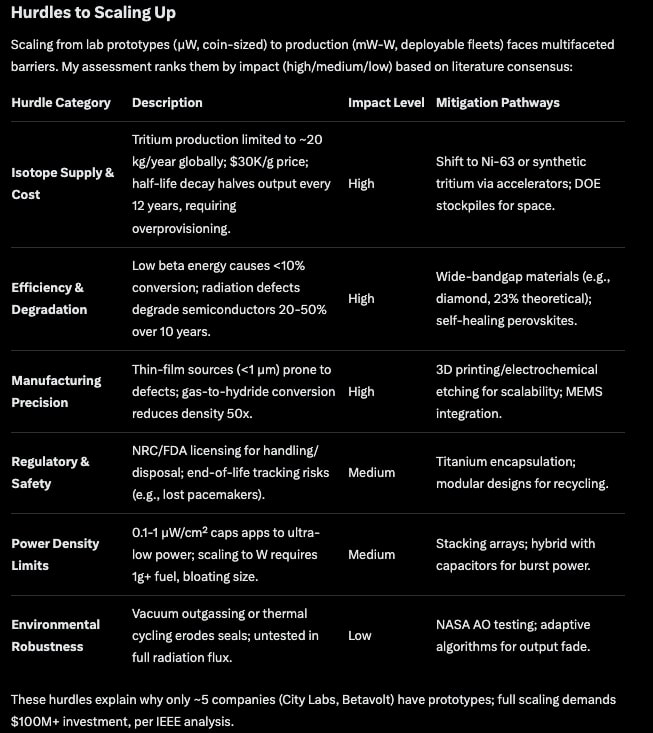
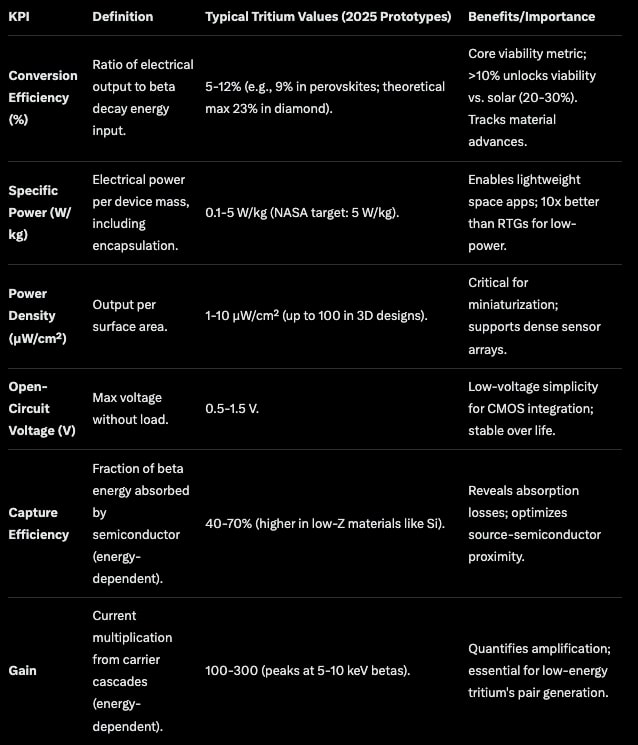
Microwatt batteries are power cells that output a charge typically measured in microwatts. They can supply a variety of charges based on their power. Low-power models output single-digit microwatts, and high-power models can supply burst charges in the milliwatt range. Microwatt batteries often power smaller devices due to their small and compact structure.
Nanowatt batteries supply electricity within the nanowatt range and can power a variety of devices. City Labs has developed betavoltaic tritium batteries to power devices in the nano-microwatt range with milliwatt burst capabilities. Nanowatt batteries feature a variety of benefits including long-term power sources and increased sustainability.
Survey of Work on Tritium Betavoltaics

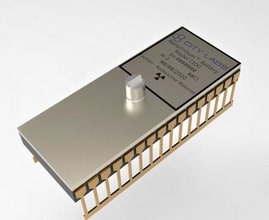
NASA-Focused Developments Autonomous Tritium Micropowered Sensors (NASA NIAC, 2025): Proposes ultrathin tritium betavoltaics integrated into Nano/Micro-Propulsion (NMP) systems for autonomous scientific instruments on small probes. Achieves ~1-10 µW in extreme conditions, enabling 20+ year missions without recharging.
Non-Solar Photovoltaics for Small Space Missions (NASA Technical Report, 2015): Reviews tritium betavoltaics as alternatives to solar/RTGs for CubeSats, noting commercialization trends and power densities up to 0.1 mW/cm². Emphasizes tritium’s safety over plutonium.
Tritium Battery Gets NASA’s Attention (ASME, 2023): Details NASA’s prototype collaboration with City Labs for tritium-based batteries in future missions, targeting 5 W/kg specific power for sensors.
New Tritium-Based Technology to Power Future NASA Missions (City Labs/NASA, 2023): Describes delivery of a long-life (20-year) tritium battery for microelectronics, with 50-100 µW output in vacuum/radiation tests.
Low Power Radioisotope Conversion Technology and Performance (NASA, 2018): Analyzes betavoltaic vs. thermoelectric conversion for remote apps, reporting tritium efficiencies of 5-8% and lifetimes over 15 years.
5 Watt per Kilogram Tritium Betavoltaic (NASA TechPort, ongoing): Tests regulatory-compliant packages for 5 W/kg batteries, focusing on reliability in space. Prototype validates 10 µW/cm² at 1 V.
Betavoltaic Power Sources for Low-Power NASA Missions (USRA, 2022): Outlines 0.1-1 mW commercial units for CLPS (Commercial Lunar Payload Services), with tritium as primary isotope.
A key innovation is tritium betavoltaic power sources, providing long-duration energy in extreme environments. The proposed 5cm x 5cm gram-scale device supports lunar spectroscopy and other applications. In-situ analyses at the Moon’s south pole are challenging due to cold, limited solar power, and prolonged darkness. Tritium betavoltaics harvest energy from radioactive decay, enabling autonomous sensing in environments unsuitable for conventional photovoltaics and chemical-based batteries.
The proposal focuses on designing an ultrathin light weight tritium betavoltaic into an NMP for integrating various scientific instruments. Tritium-powered NMPs support diverse applications, from planetary science to scouting missions for human exploration. This approach enables large-scale deployment for high-resolution remote sensing. For instance, a distributed NMP array could map lunar water resources, aiding Artemis missions. Beyond the Moon, tritium-powered platforms enable a class of missions to Mars, Europa, Enceladus, and asteroids, where alternative power sources are impractical.
Phase II objectives focus on improving energy conversion efficiency and resilience of tritium betavoltaic power sources, targeting 1-10 μW continuous electrical power with higher thermal output. The project will optimize NMP integration with sensor platforms, enhancing power management, data transmission, and environmental survivability in PSR conditions. Environmental testing will assess survivability under lunar landing conditions, including decelerations of 27,000-270,000g and interactions with lunar regolith. The goal is to advance TRL from 2 to 3 by demonstrating proof-of-concept prototypes and preparing for TRL 4. Pathways for NASA mission integration will be explored, assessing scalability, applicability, and cost-effectiveness compared to alternative technologies.
A key discovery in Phase I was the thermal-survivability benefit of the betavoltaic’s tritium metal hydride, which generates enough heat to keep electronic components operational. This dual functionality–as both a power source and thermal stabilizer–allows NMP components to function within temperature specifications, a breakthrough for autonomous sensing in extreme environments. Beyond lunar applications, this technology could revolutionize planetary science, deep-space exploration, and terrestrial use cases. It could aid Mars missions, where dust storms and long nights challenge solar power, and Europa landers, which need persistent low-power operation. Earth-based applications such as biomedical implants and environmental monitoring could benefit from the proposed advancements in betavoltaic energy storage and micro-scale sensors. The Phase II study supports NASA’s Artemis objectives by enabling sustainable lunar exploration through enhanced resource characterization and autonomous monitoring. Tritium-powered sensing has strategic value for PSR scouting, planetary-surface mapping, and deep-space monitoring. By positioning tritium betavoltaic NMPs as a power solution for extreme environments, this study lays the foundation for transitioning the technology from concept to implementation, advancing space exploration and scientific discovery.

Brian Wang is a Futurist Thought Leader and a popular Science blogger with 1 million readers per month. His blog Nextbigfuture.com is ranked #1 Science News Blog. It covers many disruptive technology and trends including Space, Robotics, Artificial Intelligence, Medicine, Anti-aging Biotechnology, and Nanotechnology.
Known for identifying cutting edge technologies, he is currently a Co-Founder of a startup and fundraiser for high potential early-stage companies. He is the Head of Research for Allocations for deep technology investments and an Angel Investor at Space Angels.
A frequent speaker at corporations, he has been a TEDx speaker, a Singularity University speaker and guest at numerous interviews for radio and podcasts. He is open to public speaking and advising engagements.


